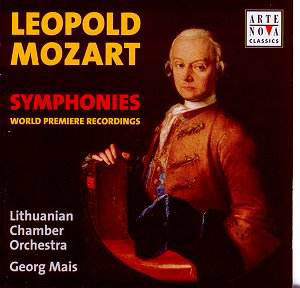Leopold’s influence on Wolfgang is beyond dispute:
that goes without saying. But we too easily think of Leopold merely
as an ambitious father who masterminded his son’s upbringing and education;
not perhaps as a composer in his own right. This interesting disc of
four (surely there was room for five?) symphonies suggest that Dad may
have exerted as much musical (in the sense of stylistic) influence on
the younger Mozart as the London (JC) Bach, commonly regarded as the
model for WA’s earliest (K16 dates from 1763) symphonies.
This music is conventional in the sense that it is
limited in terms of outlook, emotional range, texture and structure.
But it is fresh, there are some agreeable surprises, and it seldom descends
into mere note-spinning.
Of the four symphonies on offer here, three are three-movement
works in the same key of D major: only the F major piece has four movements.
Major-mode brightness gives way only very occasionally to minor-mode
darkness, most notably in the trio of F5’s minuet, where there is even
a little counterpoint and chromaticism to treasure. Uniquely, D24 has
a slow introduction, and the 2nd theme of its opening movement (an oddly
syncopated affair…) is approached by means of a wholly unexpected (Haydnesque)
abrupt halt!
Strings predominate: the 1st violins (who
ought to be on some sort of bonus…) are the almost invariable rule when
it comes to melodic material: violas and cellos stay patiently and obediently
in the background. Some of these pieces include pairs of horns and oboes,
but only in one (D24) do they appear in every movement: the odd trilling
horn pedal excepted, these instruments (typically) contribute little
more than harmonic colour.
The performances are vivacious indeed: precisely articulated
and well rehearsed. But, like the music itself, they tend to adopt one
of two dynamic levels (you’ve got it: loud and soft) which, if anything,
contributes to – rather than limits, as the best performances would
– the danger of monotony. Even so, it is difficult not to enjoy
the proceedings.
The recording is admirably clear: brightly lit, but
as full and as warm as one could want. There are one or two poor edits
(try 1' 20" into track 5!) and several instances of the (fairly reverberant)
acoustic being damped unnecessarily quickly at the ends of movements.
The booklet is no tome, but it is informative and well-written.
If you like your early classical symphonies, or if
you’re curious about the great Mozart’s formative years, this disc affords
an inexpensive opportunity to widen your horizons. It’s widened mine,
but I confess it hasn’t stirred my soul!
Peter J Lawson


![]() See
what else is on offer
See
what else is on offer 